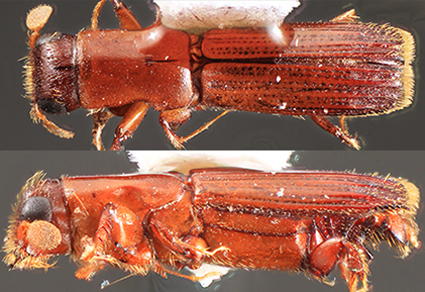Abstract
We describe three new species of Myoplatypus Wood, 1993: from Peru, Myoplatypus petrovi Kirkendall new species; from Honduras, M. quadricornis Kirkendall new species; from Nicaragua (M. nicaraguensis Kirkendall new species). We transfer Platypus biprorus Blandford, 1896 and Platypus sicarius Wood, 1971 into Myoplatypus, and we synonymize Platypus querceus Wood, 1971 with M. biprorus. The net result of these actions is a genus comprising nine tropical and one temperate American species. Males of all species are illustrated by photographs and a key to all species is provided. The collections reported here include the first South American records of Myoplatypus, a genus hitherto known only from North and Central America. Most Myoplatypus species are known from just one or a few collections and none of the tropical species are very widespread; only five tropical species have any known hosts (Quercus [Fagaceae] for three of them). The paucity of specimens could be because of peculiarities of biology that lead to them being under-collected (such as restriction to high elevations), but it also could be that they are narrow endemics, in which case these pinhole borer species deserve conservation attention.
Nosotros describimos tres nuevas especies de Myoplatypus Wood, 1993: de Perú, Myoplatypus petrovi Kirkendall espécie nueva; de Honduras, M. quadricornis Kirkendall espécie nueva; de Nicaragua, M. nicaraguensis Kirkendall espécie nueva. Platypus biprorus Blandford, 1896 y Platypus sicarius Wood, 1971 se transfieren a Myoplatypus, y Platypus querceus Wood, 1971 se sinonimiza con M. biprorus Blandford. El resultado neto de estas acciones es un género que consiste en nueve espécies tropicales y una templada. Los machos de todas las especies están ilustrados con fotografías y se da una clave para todas las especies. Las colecciones reportadas aquí incluyen los primeros registros sudamericanos de Myoplatypus, un género hasta ahora conocido solo en América del Norte y América Central. La mayoría de las especies de Myoplatypus se conocen a partir de solo una o unas pocas colecciones y ninguna de las especies tropicales está muy extendida; sólo cinco especies tropicales tienen hospedadores conocidos (tres de ellos son robles). La escasez de especímenes podría deberse a algunas peculiaridades de la biología que los llevan a una recolección insuficiente (como la restricción a grandes alturas), pero también podría ser que sean endémicos estrechos, en cuyo caso estas especies de barrenadores merecen atención de conservación.
References
- Alonso-Zarazaga, M.A. & Lyal, C.H.C. (2009) A catalogue of family and genus group names in Scolytinae and Platypodinae with nomenclatural remarks (Coleoptera: Curculionidae). Zootaxa, 2258 (1), 11–34. https://doi.org/10.11646/zootaxa.2258.1.1
- Beaver, R.A. (2007) A new Oriental genus of pinhole borer (Coleoptera: Curculionidae: Platypodinae). Entomologist’s Monthly Magazine, 143, 17–25.
- Blandford, W.F.H. (1895) Subfam. Platypodinae. Biologia Centrali-Americana, 4 (6), 89–118.
- Coster, J.E. (1969) Observations on Platypus flavicornis (Coleoptera: Platypodidae) in southern pine beetle infestations. Annals of the Entomological Society of America, 62, 1008–1011. https://doi.org/10.1093/aesa/62.5.1008
- Jordal, B.H. (2014) Platypodinae. In: Leschen, R. & Beutel, R. (Eds.), Handbook of Zoology. Arthropoda: Insecta: Coleoptera, Morphology and Systematics (Phytophaga). Vol. 3. De Gruyter Press, Berlin/New York, pp. 358–364.
- Kirkendall, L.R. (2017) Beetles (Coleoptera) of Peru: A survey of the families. Curculionidae: Platypodinae. The Coleopterists Bulletin, 71, 99–115. https://doi.org/10.1649/0010-065X-71.1.99
- Kirkendall, L.R. & Atkinson, T.H. (2023) What we do and don’t know about New World pinhole borers (Coleoptera, Curculionidae, Platypodinae). Norwegian Journal of Entomology. [submitted]
- Kirkendall, L.R., Biedermann, P.H.W. & Jordal, B.H. (2015) Evolution and diversity of bark and ambrosia beetles. In: Vega, F.E. & Hofstetter, R.W. (Eds.), Bark beetles—Biology and Ecology of Native and Invasive Species. Academic Press, Cambridge, Massachusetts, pp. 85–156. https://doi.org/10.1016/B978-0-12-417156-5.00003-4
- Petrov, A.V. (2014) A new genus and two new species of Scolytinae (Coleoptera: Curculionidae) from Peru. Lesnoy Vestnik, 18, 149–154.
- Petrov, A.V. (2020) New species and records of Xyleborini (Coleoptera, Curculionidae: Scolytinae) from Peru. Russian Entomological Journal, 29, 402–409. https://doi.org/10.15298/rusentj.29.4.07
- Petrov, A.V. & Mandelshtam, M.Y. (2009) New data on ambrosia-beetles of the genus Sampsonius Eggers, 1935 with descriptions of two new species from Peru (Coleoptera: Curculionidae: Scolytinae). Koleopterologische Rundschau, 79, 313–319.
- Petrov, A.V. & Mandelshtam, M.Y. (2010) New data on Neotropical Scolytus Geoffroy, 1762 with description of five new species from Peru (Coleoptera, Curculionidae, Scolytinae). ZooKeys, 56, 65–104. https://doi.org/10.3897/zookeys.56.519
- Schedl, K.E. (1972) Monographie der Familie Platypodidae Coleoptera. W. Junk, Den Haag, 322 pp.
- Smith, S.M. & Cognato, A.I. (2021) A revision of the Neotropical genus Coptoborus Hopkins (Coleoptera, Curculionidae, Scolytinae, Xyleborini). ZooKeys, 1044, 609–720. https://doi.org/10.3897/zookeys.144.62246
- Wood, S.L. (1966) New records and species of neotropical Platypodidae (Coleoptera). Great Basin Naturalist, 26, 45–70. https://doi.org/10.5962/bhl.part.14261
- Wood, S.L. (1971) New records and species of American Platypodidae (Coleoptera). Great Basin Naturalist, 31, 243–253. https://doi.org/10.5962/bhl.part.28042
- Wood, S.L. (1993) Revision of the genera of Platypodidae (Coleoptera). Great Basin Naturalist, 53, 259–281. https://doi.org/10.5962/bhl.part.16605


